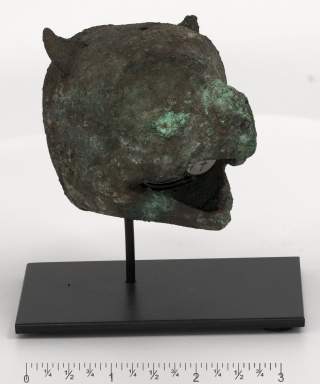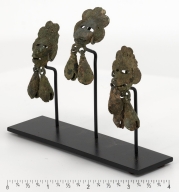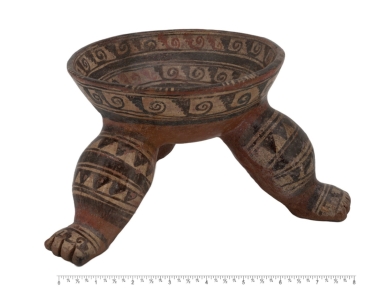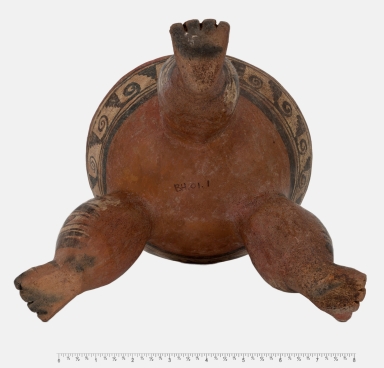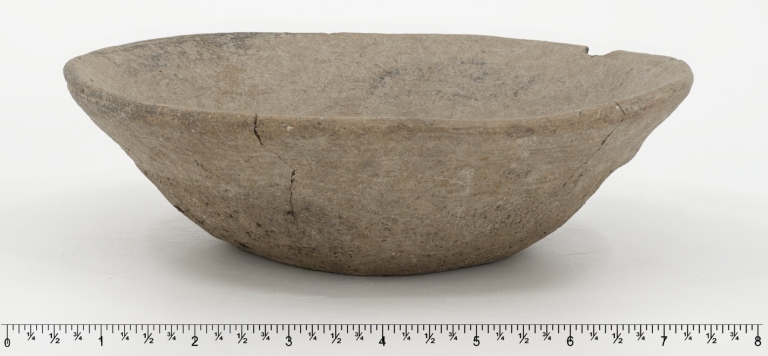|
REFINE
Browse All : Mixtec art--Antiquities
1-25 of 25
Title
Owl Maskette
Description
This hollow, open-back copper maskette was cast using the lost-wax technique. The owl maskette was formed first in bees wax. The bees wax maskette was embedded in a super fine material such as clay. The clay and beeswax maskette was slowly heated melting out the bees wax and hardening the clay matrix. Molten metal was poured into the empty maskette are and cooled.
Subject
[Masks--Mexico, Aztec art--Mexico, Mixtec art--Antiquities, Purépecha art--Mexico, Indigenous peoples--Antiquities]
Date
between 900 and 1200
Title
Owl Maskette
Description
This hollow, open-back copper maskette was cast using the lost-wax technique. The owl maskette was formed first in bees wax. The bees wax maskette was embedded in a super fine material such as clay. The clay and beeswax maskette was slowly heated melting out the bees wax and hardening the clay matrix. Molten metal was poured into the empty maskette are and cooled.
Subject
[Masks--Mexico, Aztec art--Mexico, Mixtec art--Antiquities, Purépecha art--Mexico, Indigenous peoples--Antiquities]
Date
between 900 and 1200
Title
Owl Maskette
Description
This hollow, open-back copper maskette was cast using the lost-wax technique. The owl maskette was formed first in bees wax. The bees wax maskette was embedded in a super fine material such as clay. The clay and beeswax maskette was slowly heated melting out the bees wax and hardening the clay matrix. Molten metal was poured into the empty maskette are and cooled.
Subject
[Masks--Mexico, Aztec art--Mexico, Mixtec art--Antiquities, Purépecha art--Mexico, Indigenous peoples--Antiquities]
Date
between 900 and 1200
Title
Owl Maskette
Description
This hollow, open-back copper maskette was cast using the lost-wax technique. The owl maskette was formed first in bees wax. The bees wax maskette was embedded in a super fine material such as clay. The clay and beeswax maskette was slowly heated melting out the bees wax and hardening the clay matrix. Molten metal was poured into the empty maskette are and cooled.
Subject
[Masks--Mexico, Aztec art--Mexico, Mixtec art--Antiquities, Purépecha art--Mexico, Indigenous peoples--Antiquities]
Date
between 900 and 1200
Title
Owl Maskette
Description
This hollow, open-back copper maskette was cast using the lost-wax technique. The owl maskette was formed first in bees wax. The bees wax maskette was embedded in a super fine material such as clay. The clay and beeswax maskette was slowly heated melting out the bees wax and hardening the clay matrix. Molten metal was poured into the empty maskette are and cooled.
Subject
[Masks--Mexico, Aztec art--Mexico, Mixtec art--Antiquities, Purépecha art--Mexico, Indigenous peoples--Antiquities]
Date
between 900 and 1200
Title
Owl Maskette
Description
This hollow, open-back copper maskette was cast using the lost-wax technique. The owl maskette was formed first in bees wax. The bees wax maskette was embedded in a super fine material such as clay. The clay and beeswax maskette was slowly heated melting out the bees wax and hardening the clay matrix. Molten metal was poured into the empty maskette are and cooled.
Subject
[Masks--Mexico, Aztec art--Mexico, Mixtec art--Antiquities, Purépecha art--Mexico, Indigenous peoples--Antiquities]
Date
between 900 and 1200
Title
Owl Maskette
Description
This hollow, open-back copper maskette was cast using the lost-wax technique. The owl maskette was formed first in bees wax. The bees wax maskette was embedded in a super fine material such as clay. The clay and beeswax maskette was slowly heated melting out the bees wax and hardening the clay matrix. Molten metal was poured into the empty maskette are and cooled.
Subject
[Masks--Mexico, Aztec art--Mexico, Mixtec art--Antiquities, Purépecha art--Mexico, Indigenous peoples--Antiquities]
Date
between 900 and 1200
Title
Copper human face pendant : 2.
Description
These hollow, open-back copper masks were cast usin the lost wax technique. There is a strap across the back so they could be secured to a headdress or a textile. The masks contained small bells which would tingle when moved.
Subject
[Pendants (Jewelry)--Mexico, Purépecha art--Antiquities, Mixtec art--Antiquities, Aztec art--Mexico, Indigenous Peoples--Antiquities]
Date
between 900 and 1200
Title
Copper human face pendant : 2.
Description
These hollow, open-back copper masks were cast usin the lost wax technique. There is a strap across the back so they could be secured to a headdress or a textile. The masks contained small bells which would tingle when moved.
Subject
[Pendants (Jewelry)--Mexico, Purépecha art--Antiquities, Mixtec art--Antiquities, Aztec art--Mexico, Indigenous Peoples--Antiquities]
Date
between 900 and 1200
Title
Copper human face pendant : 2.
Description
These hollow, open-back copper masks were cast usin the lost wax technique. There is a strap across the back so they could be secured to a headdress or a textile. The masks contained small bells which would tingle when moved.
Subject
[Pendants (Jewelry)--Mexico, Purépecha art--Antiquities, Mixtec art--Antiquities, Aztec art--Mexico, Indigenous Peoples--Antiquities]
Date
between 900 and 1200
Title
Copper human face pendant : 2.
Description
These hollow, open-back copper masks were cast usin the lost wax technique. There is a strap across the back so they could be secured to a headdress or a textile. The masks contained small bells which would tingle when moved.
Subject
[Pendants (Jewelry)--Mexico, Purépecha art--Antiquities, Mixtec art--Antiquities, Aztec art--Mexico, Indigenous Peoples--Antiquities]
Date
between 900 and 1200
Title
Copper human face pendant : 2.
Description
These hollow, open-back copper masks were cast usin the lost wax technique. There is a strap across the back so they could be secured to a headdress or a textile. The masks contained small bells which would tingle when moved.
Subject
[Pendants (Jewelry)--Mexico, Purépecha art--Antiquities, Mixtec art--Antiquities, Aztec art--Mexico, Indigenous Peoples--Antiquities]
Date
between 900 and 1200
Title
Copper human face pendant : 2.
Description
These hollow, open-back copper masks were cast usin the lost wax technique. There is a strap across the back so they could be secured to a headdress or a textile. The masks contained small bells which would tingle when moved.
Subject
[Pendants (Jewelry)--Mexico, Purépecha art--Antiquities, Mixtec art--Antiquities, Aztec art--Mexico, Indigenous Peoples--Antiquities]
Date
between 900 and 1200
Title
Mixtec tripodal bowl.
Description
The number three appears to have significance. It appears as three legs, three solid bands, three stepped spiral rings and two of those rings are divided into three quadrants. There are three realms in Mesoamerica: Heaven, the Sky, Earth, the living world, and the Underworld, the land of the dead.
Subject
[Ceramic bowls--Mexico, Ceramic tableware--Mexico, Pottery--Mexico, Mixtec art--Antiquities, Indigenous peoples--Antiquities]
Date
between 900 and 1400
Title
Mixtec tripodal bowl.
Description
The number three appears to have significance. It appears as three legs, three solid bands, three stepped spiral rings and two of those rings are divided into three quadrants. There are three realms in Mesoamerica: Heaven, the Sky, Earth, the living world, and the Underworld, the land of the dead.
Subject
[Ceramic bowls--Mexico, Ceramic tableware--Mexico, Pottery--Mexico, Mixtec art--Antiquities, Indigenous peoples--Antiquities]
Date
between 900 and 1400
Title
Mixtec tripodal bowl.
Description
The number three appears to have significance. It appears as three legs, three solid bands, three stepped spiral rings and two of those rings are divided into three quadrants. There are three realms in Mesoamerica: Heaven, the Sky, Earth, the living world, and the Underworld, the land of the dead.
Subject
[Ceramic bowls--Mexico, Ceramic tableware--Mexico, Pottery--Mexico, Mixtec art--Antiquities, Indigenous peoples--Antiquities]
Date
between 900 and 1400
Title
Mixtec tripodal bowl.
Description
The number three appears to have significance. It appears as three legs, three solid bands, three stepped spiral rings and two of those rings are divided into three quadrants. There are three realms in Mesoamerica: Heaven, the Sky, Earth, the living world, and the Underworld, the land of the dead.
Subject
[Ceramic bowls--Mexico, Ceramic tableware--Mexico, Pottery--Mexico, Mixtec art--Antiquities, Indigenous peoples--Antiquities]
Date
between 900 and 1400
Title
Mixtec tripodal bowl.
Description
The number three appears to have significance. It appears as three legs, three solid bands, three stepped spiral rings and two of those rings are divided into three quadrants. There are three realms in Mesoamerica: Heaven, the Sky, Earth, the living world, and the Underworld, the land of the dead.
Subject
[Ceramic bowls--Mexico, Ceramic tableware--Mexico, Pottery--Mexico, Mixtec art--Antiquities, Indigenous peoples--Antiquities]
Date
between 900 and 1400
Title
Mixtec tripodal bowl.
Description
The number three appears to have significance. It appears as three legs, three solid bands, three stepped spiral rings and two of those rings are divided into three quadrants. There are three realms in Mesoamerica: Heaven, the Sky, Earth, the living world, and the Underworld, the land of the dead.
Subject
[Ceramic bowls--Mexico, Ceramic tableware--Mexico, Pottery--Mexico, Mixtec art--Antiquities, Indigenous peoples--Antiquities]
Date
between 900 and 1400
Title
Grayware offering bowl.
Description
A small grayware bowl with flaring sides contains a stone carving of Mictlantecuhtli, the Lord of death. The stone carving and the grayware bowl with organic material would represent an offering to the God of death.
Subject
[Ceramic bowls--Mexico--Mitla Site, Pottery--Mexico--Mitla Site, Mixtec art--Antiquities, Indigenous peoples--Antiquities]
Date
between 900 and 1521
Title
Grayware offering bowl.
Description
A small grayware bowl with flaring sides contains a stone carving of Mictlantecuhtli, the Lord of death. The stone carving and the grayware bowl with organic material would represent an offering to the God of death.
Subject
[Ceramic bowls--Mexico--Mitla Site, Pottery--Mexico--Mitla Site, Mixtec art--Antiquities, Indigenous peoples--Antiquities]
Date
between 900 and 1521
Title
Grayware offering bowl.
Description
A small grayware bowl with flaring sides contains a stone carving of Mictlantecuhtli, the Lord of death. The stone carving and the grayware bowl with organic material would represent an offering to the God of death.
Subject
[Ceramic bowls--Mexico--Mitla Site, Pottery--Mexico--Mitla Site, Mixtec art--Antiquities, Indigenous peoples--Antiquities]
Date
between 900 and 1521
Title
Grayware offering bowl.
Description
A small grayware bowl with flaring sides contains a stone carving of Mictlantecuhtli, the Lord of death. The stone carving and the grayware bowl with organic material would represent an offering to the God of death.
Subject
[Ceramic bowls--Mexico--Mitla Site, Pottery--Mexico--Mitla Site, Mixtec art--Antiquities, Indigenous peoples--Antiquities]
Date
between 900 and 1521
Title
Grayware offering bowl.
Description
A small grayware bowl with flaring sides contains a stone carving of Mictlantecuhtli, the Lord of death. The stone carving and the grayware bowl with organic material would represent an offering to the God of death.
Subject
[Ceramic bowls--Mexico--Mitla Site, Pottery--Mexico--Mitla Site, Mixtec art--Antiquities, Indigenous peoples--Antiquities]
Date
between 900 and 1521
Title
Grayware offering bowl.
Description
A small grayware bowl with flaring sides contains a stone carving of Mictlantecuhtli, the Lord of death. The stone carving and the grayware bowl with organic material would represent an offering to the God of death.
Subject
[Ceramic bowls--Mexico--Mitla Site, Pottery--Mexico--Mitla Site, Mixtec art--Antiquities, Indigenous peoples--Antiquities]
Date
between 900 and 1521
1-25 of 25
|


